Why I Bought Leica M9 In 2021
I could've titled this as "Why I Bought Leica M9 In 2020, See It Break Before My Eyes, Cry And Buy Another Leica M9 In 2021". It might be a bit too excessive though.
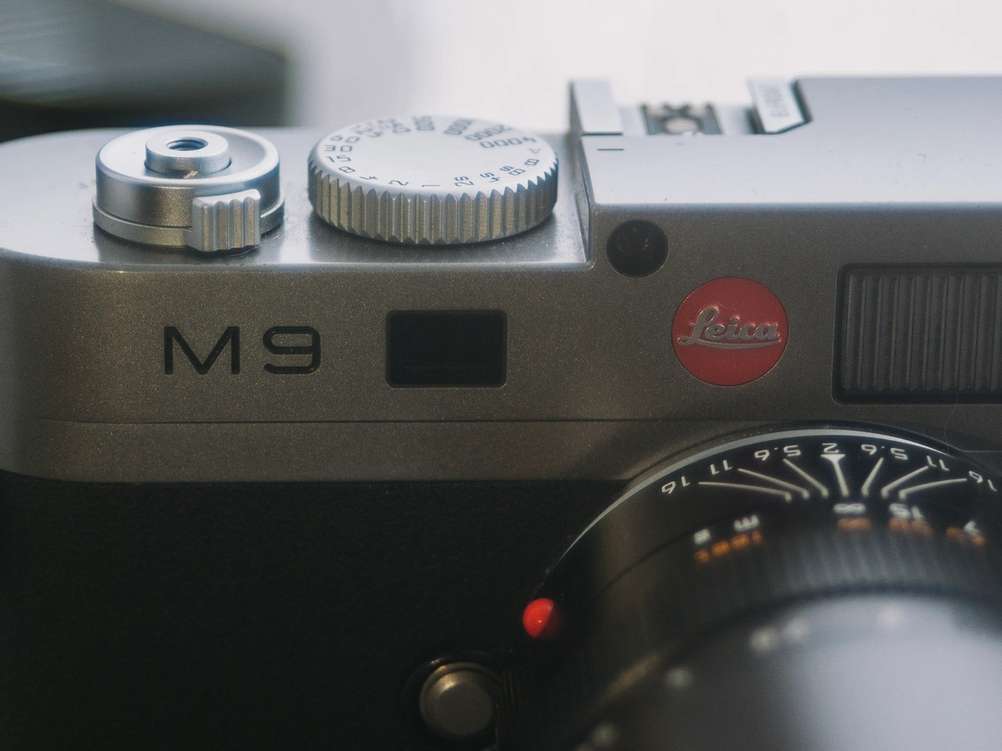
Photo of an amazing CCD camera taken with another amazing CCD camera - Pentax K10D!
Brief History About Leica M9
The first digital rangefinder camera was the Epson R-D1. The first digital Leica rangefinder camera was Leica M8. And coming in third of the firsts - the first digital, full-frame, rangefinder camera was Leica M9.
It was introduced in 2009 and had a 18.5 megapixel CCD sensor ( developed by Kodak! ).
Sadly - it had quite a major problem. The CCD sensor was plagued with corrosion issues. I won't go into much detail about what causes the issue as you can find better information about it elsewhere. It presented itself as permanent dust-like spots on the final images. And it would only get worse over time. Similar to dust spots - it isn't always visible. For example on busy backgrounds or when shooting wide open you could easily not spot ( hahaaa ) the issue. But it would get worse over time and other issues could present themselves.
Initially Leica did free sensor replacements. Then paid sensor replacements. And then no sensor replacements but would offer you a discount for a new Leica camera in exchange for Leica M9.
Because of this reason people don't recommend buying Leica M9.
Why I Bought Leica M9 In 2020
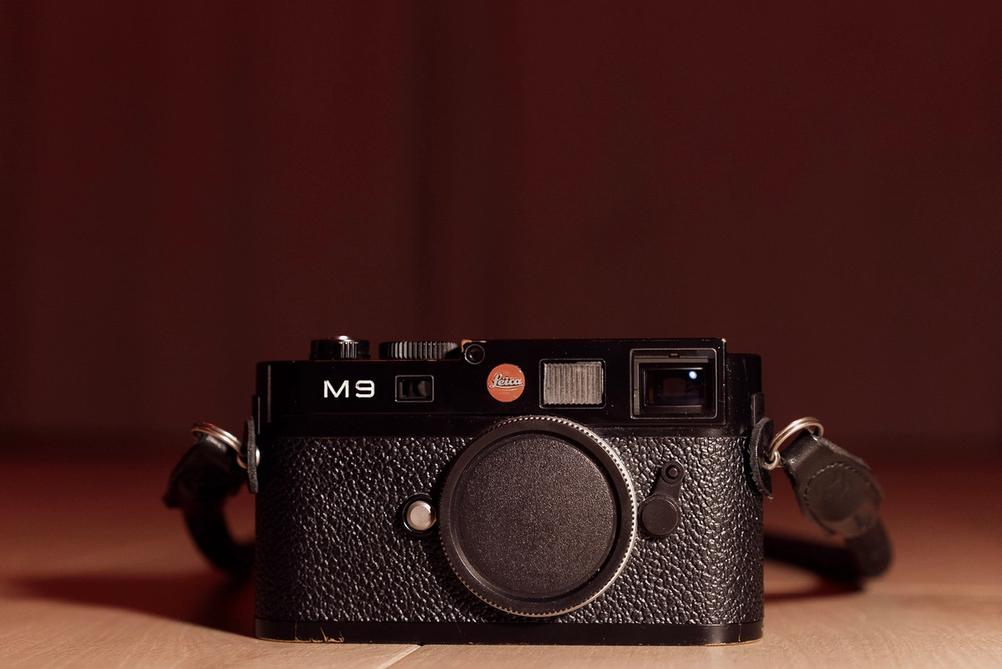
My first Leica M9. With a secret inside!
I had been shooting Leica M3 for a while and desired a digital rangefinder camera since I still like digital and am not 100% analog convert. There is a problem though - digital rangefinder cameras are expensive.
Firstly - there aren't that many real digital rangefinder cameras. There's the Epson R-D1, Leica M digital cameras and now also Pixii camera. I wanted a full frame camera so Epson, Pixii and Leica M8 were out. I wouldn't mind trying / having a smaller sensored rangefinder camera but not as my first rodeo with digital rangefinders. And it's also not like they are much cheaper than full frame ones ( and can be more expensive as well ).
I was left with Leica M9 ( and variants ), M Type 240 ( and variants ), M Type 262 ( and variants ) and M10 ( and variants ). They are listed in chronological order by the release date. Because I didn't want to ( and couldn't ) spend a lot - realistically I could only consider M9.
M9 bodies with sensor issues could be purchased for not too high prices - at least when compared to other digital Leica M bodies. I would still classify them as high for what essentially is a 11 year old camera ( at the time ) with a time bomb inside. Still - I was willing to consider this as an option if one came along with the right price.
And it did - I found one for a very cheap price ( still - in relation to other Leica M cameras ) but it had an issue. Well two. First was the sensor corrosion. That's nothing. Second issue was...that the sensor was cracked in one corner. The camera still worked but you could definitely see the crack in the pictures. It didn't produce color casts or anything - just a black, janky line where the crack is. I went ahead and bought the camera.
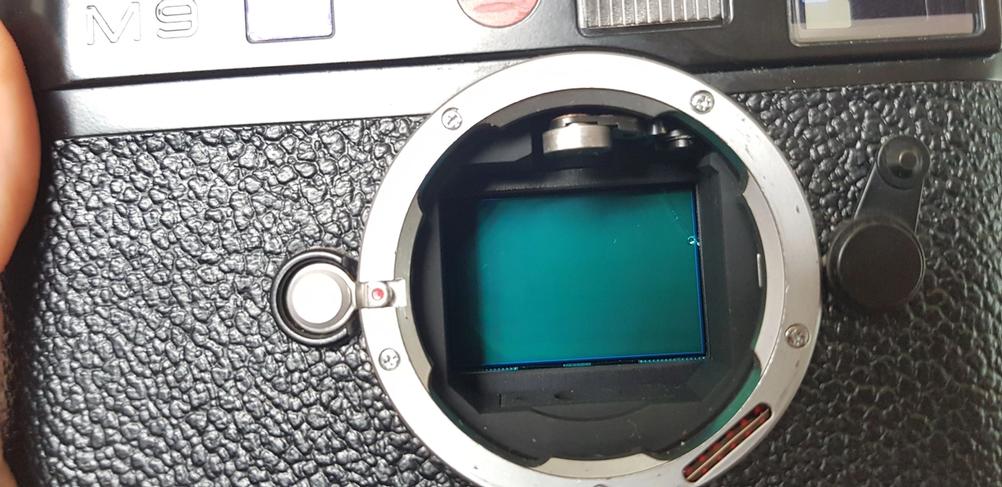
Here's the crack in all its glory. Top right corner of the sensor in the picture. Still produces better images than most other sensors!

- Camera
- Leica M9
- Lens
- Leica Summicron-M Pre-ASPH 90mm f2
Here you can see the effect that a crack can give to an image. Most amazing!
You might think that I'm not right in the head for doing it. I might even think that it wasn't the best idea. My justification was that even if it broke I could still sell it and get most of the money back as the price was just barely higher than what other broken Leica M9's were selling for. It also came with a strap and SD card - deal of the century!
Falling In Love With Leica M9
I received the sensor-cracked M9 and started shooting. First test shots were done inside the house and then in the evening I took my daughter to a nearby forest to shoot some sunset photos ( is it a weird place for sunset photos? ).
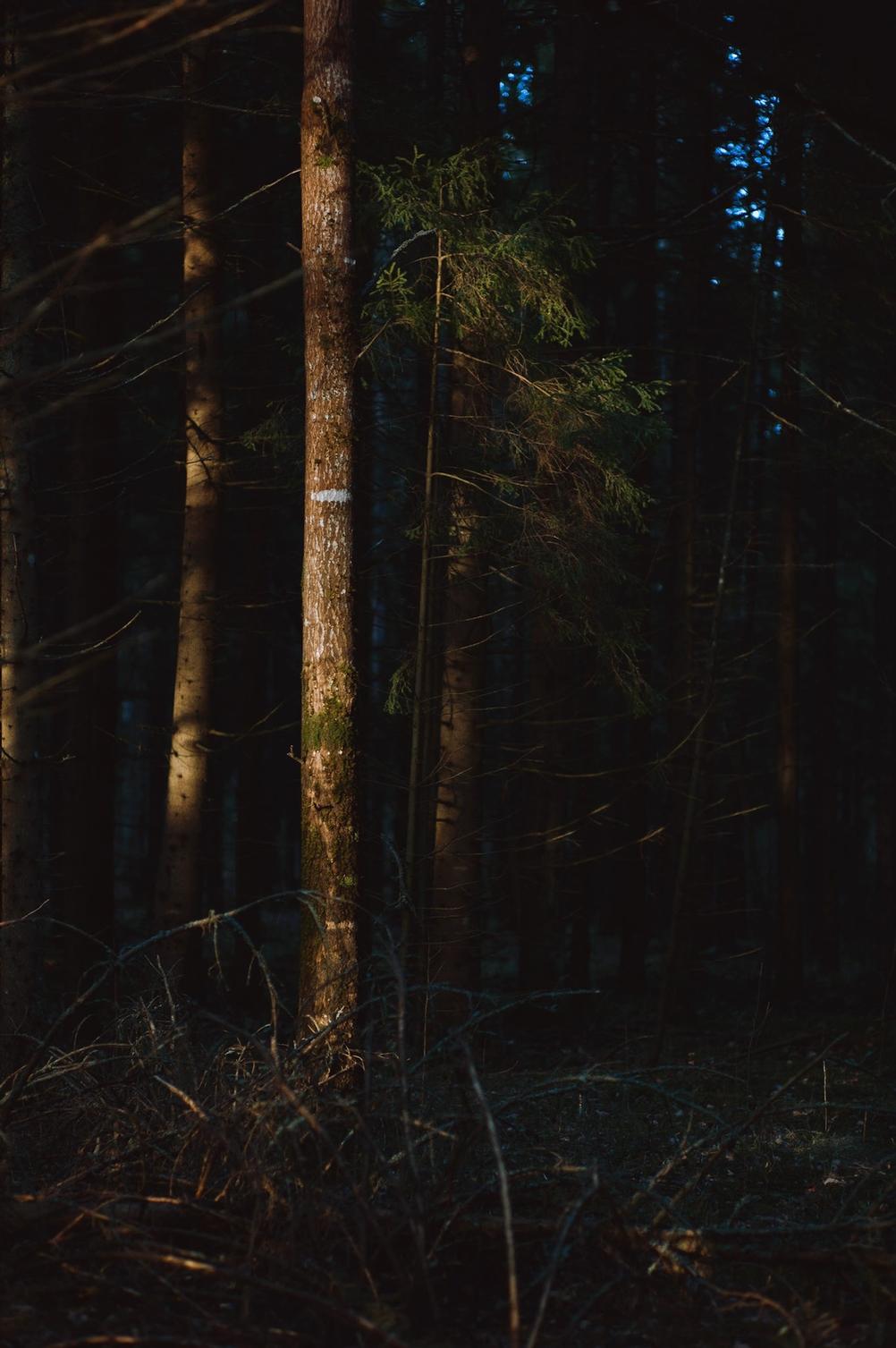
- Camera
- Leica M9
- Lens
- Leica Summicron-M Pre-ASPH 90mm f2
First sunset photo. In forest. Not much of a sunset. More like just a tree that gets blasted with sun.
LCD showed that it was indeed taking photos. The LCD on M9 is not good. But you can still see whether a picture was taken or not.
Later in the evening I imported all the photos in Lightroom and was amazed. Firstly the crack ( and corrosion ) wasn't that noticeable. In some pictures you might even miss it all together. And where it was too bothersome I could either crop it out or try to clone the worst parts out. Secondly - I just loved how the pictures looked.

- Camera
- Leica M9
- Lens
- 7Artisans 50mm f1.1
Because of the editing - you can't really tell that there is a crack induced image problem. You can't always edit yourself away from the crack - but sometimes it just melts away.
It's difficult to point at the exact reason why I liked them so much.
Partly it's the colors. Some photos I would even not want to touch colors on which almost never happens for me in digital. And for other photos it was very easy to adjust colors to what I want and more. You might laugh but I partly attribute this to the sensor being a CCD sensor instead of CMOS. I have an old Pentax K10D which has a CCD sensor and it also has pretty great color output - not as good as M9 but still great. I don't hate CMOS as it clearly has many advantages but I do have to massage the colors more to make them more pleasing to my eyes.
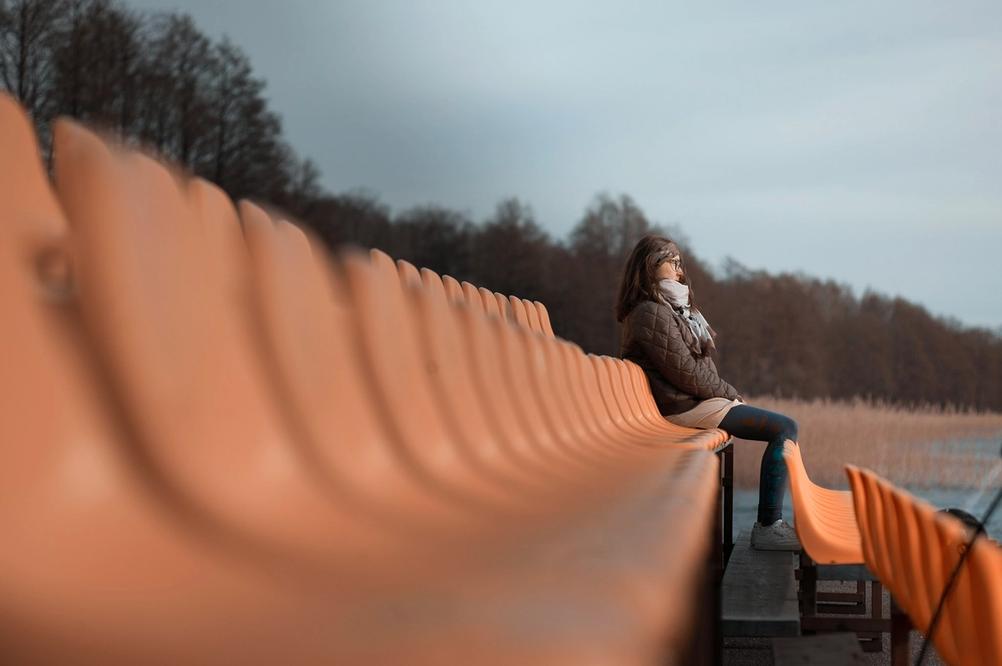
- Camera
- Leica M9
- Lens
- Leica Summicron-M Pre-ASPH 90mm f2
This image is edited. In colors as well. But it was easy to get to this stage and I didn't have to spend a lot of time to get here. I don't know what is the cause for this. I'm sure you can get this ( and better ) output from any decent camera, but for me it's just easier to do with M9.
Partly it's the clarity / sharpness. Lack of anti-aliasing filter in front of the sensor and the quite amazing lenses on M mount - photos appeared very crispy and detailed. As long as focus was nailed.

- Lens
- Leica Summicron-M Pre-ASPH 90mm f2
Good sharpness. As always - you can get sharp photos from most cameras with decent lenses. But it looks pleasing here. Not clinically so - just nice and sharp.
At partly - the "worse than modern digital cameras" dynamic range. It may sound like a negative but it isn't. Somehow the images have a really nice transition between different shades and intensity of light. Also when it gets too over-exposed it's quite natural looking. May I even call it - filmic looking - which is clearly the gold standard of how things should look!
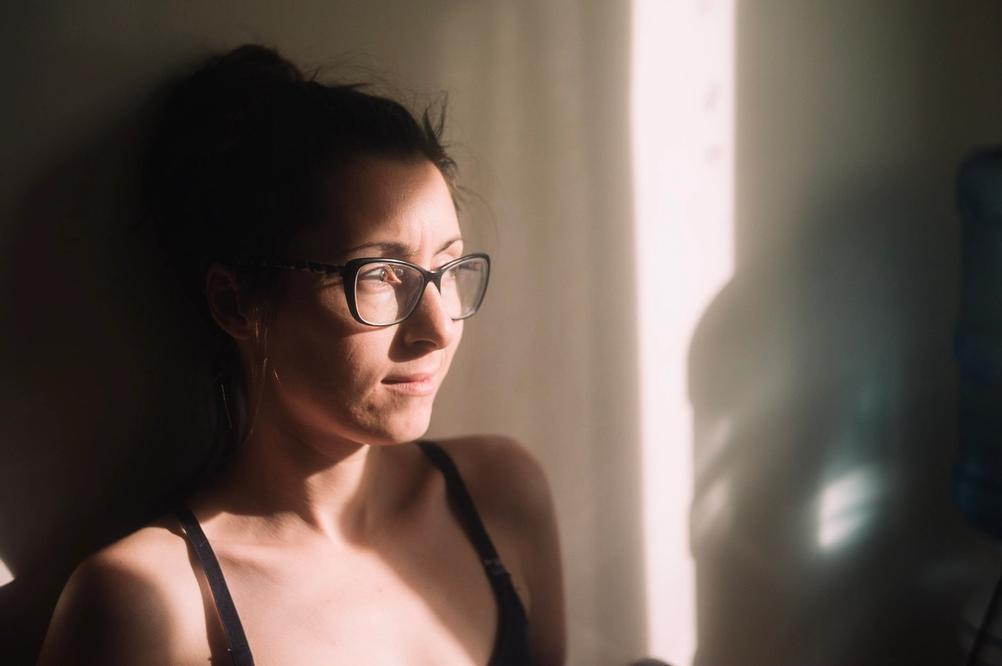
- Camera
- Leica M9
- Lens
- Canon LTM 50mm f1.8
I'm not sure if this is a good photo to showcase the "not so great" dynamic range but I like the photo and it has some very hard light.
The light on the wall is very strong and is likely blowing out a bit but still looks pleasing and not like a white mess of pixels.
It may seem that I can't really describe why I like the photos from M9. That I just attribute it to some "magic". And it's true. It's also subjective. But that doesn't mean that it's false - at least for me.
Anyway - I just continued shooting the partly broken and beaten M9. And I loved almost every second of it.

- Camera
- Leica M9
- Lens
- Leica Summicron-M Pre-ASPH 90mm f2
Let me tell you that trying to focus on a pretty fast moving soap bubble is not the easiest thing in the world with a rangefinder. It's definitely easier to justify trying with a digital camera though!
The Death Of My First M9
Sadly a day came when I took a picture and noticed that half of the frame was with a light purple cast. Then I took more photos and the issue became way worse. Half of the frame was now severely purple and somewhat under-exposed looking. Other half was also purple but less so. Contrasty edges had weird effects around them. It wasn't looking good. Maybe I could've used it as the ultimate lomography machine...
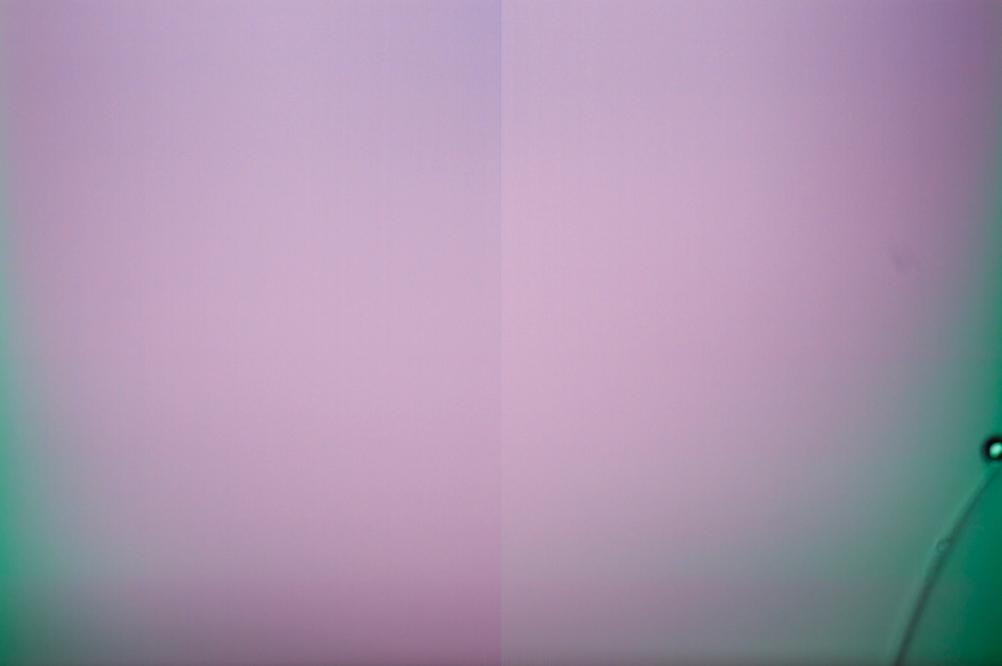
- Camera
- Leica M9
Here are some examples of the very last images I took with the first M9. There's no processing done on them at all.
Wall picture shows how a simple, gray wall can be transformed to an interesting art piece by the help of a broken sensor.
Window picture shows that sweet, sweet Lomochrome Purple look.
Drumset picture doesn't even look like a picture anymore. It looks computer generated.
Maybe I should've kept the first M9 as a special effects camera.
After some research ( that's what Googling is, right? ) it appears to be an issue that can happen with Leica M9's. It's called "purple curtain" and the only solution is sensor replacement. Which you can't do anymore.
Camera broke after roughly half a year of usage.
I was quite sad. Out of all digital shots taken in this half year - about 90% were taken with the M9 and I wasn't planning on taking any less. And it happened so suddenly - no warning or nothing ( if you look past the cracked sensor and corrosion - just your everyday things ).
There was nothing left to do but to sell the camera. Which I did. Luckily I did get most of the money back as even broken Leica M9's still go for quite a lot of money. It did put a dent in my love for Leica M9 though.
I didn't really feel like spending that money again ( even if most of it could be regained ) to buy a camera that could die on you any day.
Looking For A New Digital Rangefinder In 2021
Fast forward a few months and I was ready to buy another digital rangefinder. In the meantime I was focussing on analog photography more. Firstly because I do enjoy it a lot. Secondly because it allowed me to use rangefinder cameras - I do love me some range findings.
This time also allowed me to reflect on things and realise that if I am going to use a digital camera - I might as well use one that I really enjoy using. And that means a rangefinder. So realistically Leica M as I still wanted a full frame body.
I decided to sell my Sony gear to raise more funds for the digital rangefinder "project". Sadly prices on Sony A7S and Sony / Zeiss 55mm f1.8 aren't that high. I also sold some other things that I had around but didn't use much.
This left me with more funds than last year. Not a lot more but it meant that I could also consider Leica M Type 240 and Type 262. Leica M10 was still above my paygrade.
And Why Was It Leica M9 Again
OK. Hear me out before you judge.
Why Was Leica M Type 240 Out
Let's look at Leica M Type 240 first. You can generally get one for slightly more than Leica M9. And on the face of it - it seems like a better camera:
- More megapixels: 18.5 -> 24.
- Better low light performance. On Leica M9 you probably wouldn't want to go much higher than ISO 800 when shooting color ( and ISO 1600 - 3200 when shooting black and white ). Type 240 could likely handle ISO 3200 when shooting color and even higher when converting to black and white.
- Live view.
- Supports optional EVF.
- Better LCD.
But when I look at it with my weird brain eyes I see these negatives:
- It has video support. You might expect this to be in positives but I don't want video in my photo cameras. Part of why I like Leica is the minimal feature set where everything is useful. I don't want more features that I don't use. I might as well use Sony then and just not use 90% of what the camera can do.
- It's bulkier. Leica M9 is already bigger than analog Leica cameras and Type 240 is bigger still.
- And the biggest worry of them all - CMOS sensor. Could it still deliver the same amazing output that Leica M9 could?
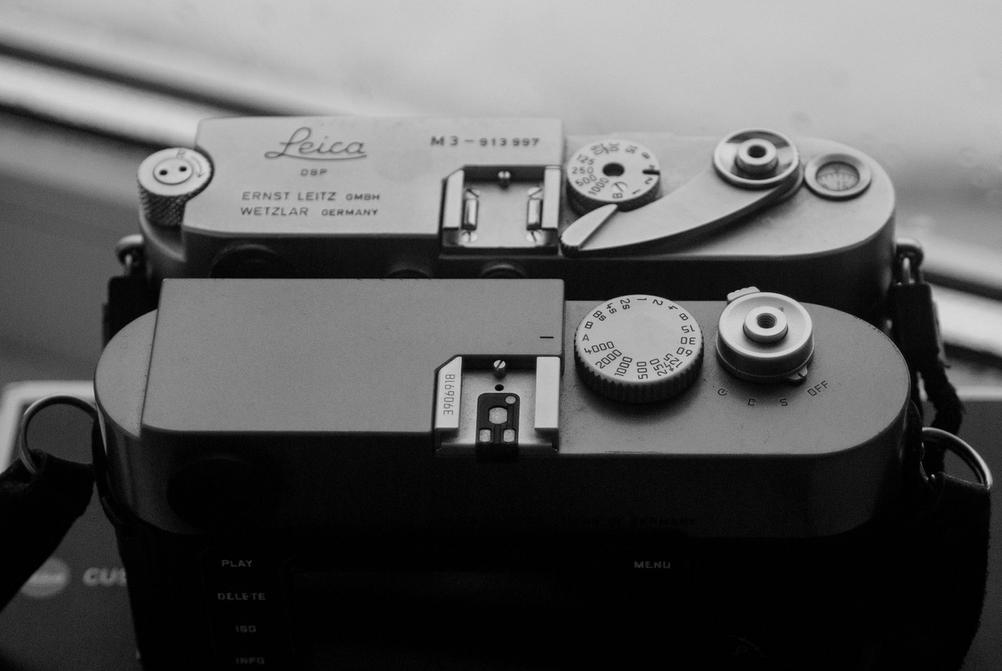
M3 vs M9. M9 is not three times larger than M3 but you can definitely see and feel the difference. I wouldn't want an even fatter camera.
Also some of the mentioned positives don't really make a difference for me:
- Live view. Maybe it's nice to have once a year but it's just another feature that I wouldn't use so why even have it.
- EVF. I wouldn't really use or even buy it so not a positive for me.
- Better LCD. I still want a digital rangefinder without a screen so a better LCD is definitely neutral for me.
- Better low light performance. It leans more on the positive side but realistically I never had issues with M9 low light performance. Just open aperture and shoot away. I guess it's a quirk from me being used to analog photography where ISO 3200 is pretty much your maximum.
- More megapixels means slower Lightroom and more disk space usage. I was still fine with Sony A7S's 12 megapixels - 18 megapixels is already an improvement.
So hopefully you can kind of see why I wasn't eager to get Type 240. If I could try one then maybe I could be convinced but I couldn't find one locally.
Why Was Leica M Type 262 Out
Type 262 was more interesting. When compared to Type 240 it had these positives:
- No video.
- Slightly smaller than Type 240 ( still bigger than M9 ).
- "Better" colors than Type 240. I put it in quotes as it's based on what I read on the internet and from some sample pictures.
Although Type 262 was announced as a cheaper version of Type 240 - on second hand marked they typically sell for more than Type 240.
Type 262 also includes the M-D version which is Type 262 without an LCD. Sadly they go for quite a lot more than regular Type 262.
I did actually find a pretty good deal for a Type 262. It was still a bit more than I would've liked to spend but I was very close to pulling the trigger. I didn't though, because...
Why Was It Leica M9 - Again
...I found a good deal on an M9 and managed to make it an even better deal.
The only M9's I considered were the ones with the replaced sensor as I wanted it to live as long as possible. The last replaced sensors apparently haven't started corroding yet ( and might never ) so they could live for more than half a year!
M9 was already a camera I knew I love so I decided to go for it again as there was no way to be disappointed ( at least not until it breaks ). If I got Type 240 or 262 - there was a chance that I wouldn't fully like the output and would still yearn for the M9. And M9's aren't getting any younger. Might as well enjoy them while they exist.
To me it seems like a no-brainer. Save a few hundred moneys and get a camera that you know you like. I'm very glad of my choice - at least unless the camera dies in the next 2 years.
The M9 I got was also in a pretty minty condition which was pleasantly surprising. I don't care much about visual problems but it's still nice to have something in mint condition. It even has plastic wrap on the bottom plate and LCD. The only downside is that it's not a black model. The first M9 I had was a black model and I do prefer black cameras in general. Not a huge issue though. There's always spray paint!
Should You Get A Leica M9? - A Short Review Of Leica M9
Do you need autofocus? If yes then you shouldn't get a M9. Get a camera with autofocus and save some money at the same time.
Have you ever shot a rangefinder? If no then you shouldn't get a M9. Try a film rangefinder first.
Do you prefer SLR type focussing over rangefinder focussing? If yes then you shouldn't get a M9. Get a dSLR or mirrorless with EVF.
Do you have to take a loan to buy it? If yes then you shouldn't get a M9. No camera is worth getting into debt for. Especially these days when you can get older used cameras for very cheap that will still deliver amazing photos.
From a usability perspective it's a dream if you like manual control or aperture priority. Aperture control is always on the lens. Shutter control is on the top of the camera. I tend to set ISO and use it for the duration of the shoot so a lack of a dedicated ISO control doesn't bother me although it would be nice. Nothing else matters. The menus are short and there's no need to go there anyway. Just set it to shoot RAW and live life carefree. You can change EV as well but I tend to not do it - if I need to tweak the exposure I will just manually set it.

M9's top plate is pleasantly simple.
There's the shutter release button with the on/off switch which also is used to change to continuous shooting mode and self timer mode.
There's also the exposure speed dial. Nothing confusing about it.
And there's the hot shoe. Not sure what you use it for - I guess external viewfinders ( I have never used a flash ).
LCD is bad - but it doesn't matter. It's good enough to roughly see whether the picture is exposed correctly. Theoretically you can check for focus if you zoom in the picture but realistically you shouldn't use it for that. I have turned the LCD off completely. I only occasionally use it to check if the picture is exposed decently or to set ISO.

Back of the Leica M9. This is also quite simple and easy to understand.
There's obviously the LCD which can display some pixels.
Play button shows the pictures taken on the very amazing LCD.
Delete button deletes the pictures that already seem bad on the LCD.
ISO button allows to set...ISO. Hold it and then turn the dial on the right of the screen. Once the desired ISO is highlighted - click Set.
Info button shows some general information about the state of the camera. Like battery info and other things. I have only used it for battery information so don't remember what's there.
Set button allows to set the selected items. Like ISO or menu settings.
On the right there's the Menu button which opens...the menu.
And a huge rotating dial and d-pad combo. It doesn't feel too good to use and is a plastic blob but it's usable. Rotating the dial in picture review mode will allow to zoom in/out of the pictures.
Overall the buttons are clickly but don't feel too good to use. They are also made from plastic. I guess Leica ran out of brass.
The viewfinder is good but not as good as Leica M3 in my opinion. Rangefinder patch is slightly smaller on M9 and it also seems to be impacted by flaring on certain circumstances which M3's patch never is. There is also less magnification which allows you to use wider lenses ( there are framelines for 28mm lenses on M9 whereas M3 taps out at 50mm ) but you will get worse experience if you prefer 50mm or longer. It's still the second best rangefinder viewfinder that I have used so it's really good.
Ergonomically it's slightly worse than M3 as it's slightly fatter. Whilst it would benefit from a grip I just can't make myself even consider one as it makes the camera look ugly...which shouldn't matter...but it kind of does. With a strap it doesn't matter though. And I might try a grip accessory that attaches to the hot shoe. Weight is nice and hefty although M3 wins here again in my opinion.

The one thing that I prefer on M9 vs M3 is the shutter speed dial. It's bigger and also easier to turn so it's quicker to set the desired shutter speed. Turning direction also makes more sense on M9.
I would like the advance lever on M9...ideally it would cock the shutter but even if it doesn't just having it there like on Leica M10D would be nice as it can be used to grip the camera easier. It does look like a penis...but an artistic looking penis!
I've already talked about image quality. If you are a fan of super high dynamic range or want to use high ISOs then this camera won't be for you - otherwise I think it produces amazing images. It's all subjective though.

- Camera
- Leica M9
- Lens
- Canon LTM 50mm f1.8
I really enjoy a look that you get when you pair M9 with some older LTM glass. Glass that might even have some haze within.
It produces some lovely muted colors and has a soft glow whilst still keeping things sharp.
I found this out on the first M9. Sadly it was briefly before it broke so I couldn't explore it more. I have done so with the new M9 though.
Ultimately - if you have an interest in digital rangefinders. Prefer a slightly different rendering than what other modern cameras would give you by default. And the downsides of this camera don't bother you. I still think it's a good choice in 2021. I wouldn't recommend it to everyone - only the ones that understand the "downsides" and even prefer them.
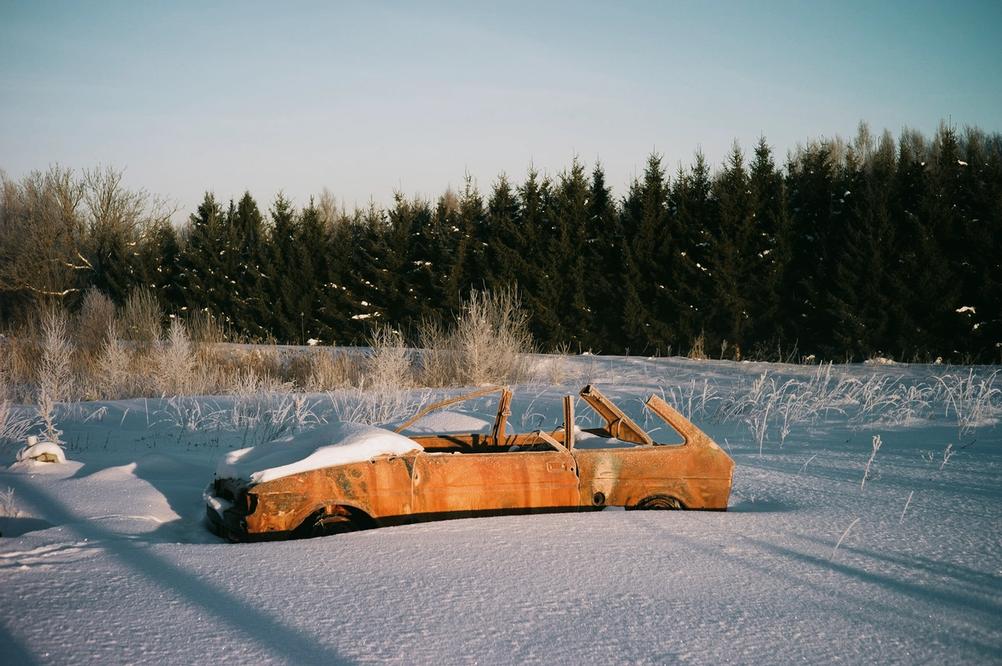
- Camera
- Leica M9
- Lens
- 7Artisans 50mm f1.1
Finally I managed to take a photo of this car when it's not in shadow.
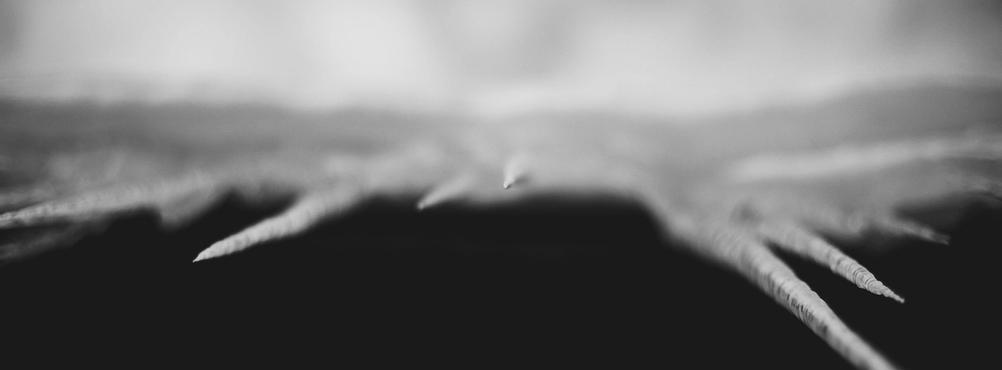
- Camera
- Leica M9
- Lens
- Canon LTM 50mm f1.2
Yeah - I have no shame cropping photos down to X-Pan ratio.

- Camera
- Leica M9
- Lens
- Canon LTM 50mm f1.8
I find this oddly pleasing. Thanks old lens rendering!
What Does The Future Hold?
Plan is to keep the M9 for as long as it will last. I hope it will be a long time.
I would like to try a more modern digital rangefinder but I wouldn't sell the M9 to fund it. I would definitely like to have a Leica M-D ( Type 262 ). Or even just a Type 262.
I would like to try the Pixii camera although it's quite expensive.
And lastly I wouldn't say no to a monochrome version. I do think that the golden standard for black and white photography is in the analog world but I can't say that for certain unless I try it with a true monochrome camera.
Ultimately I like trying new things. Sadly digital rangefinders is an expensive section of photography so it will definitely be hard to try everything that I want to try.
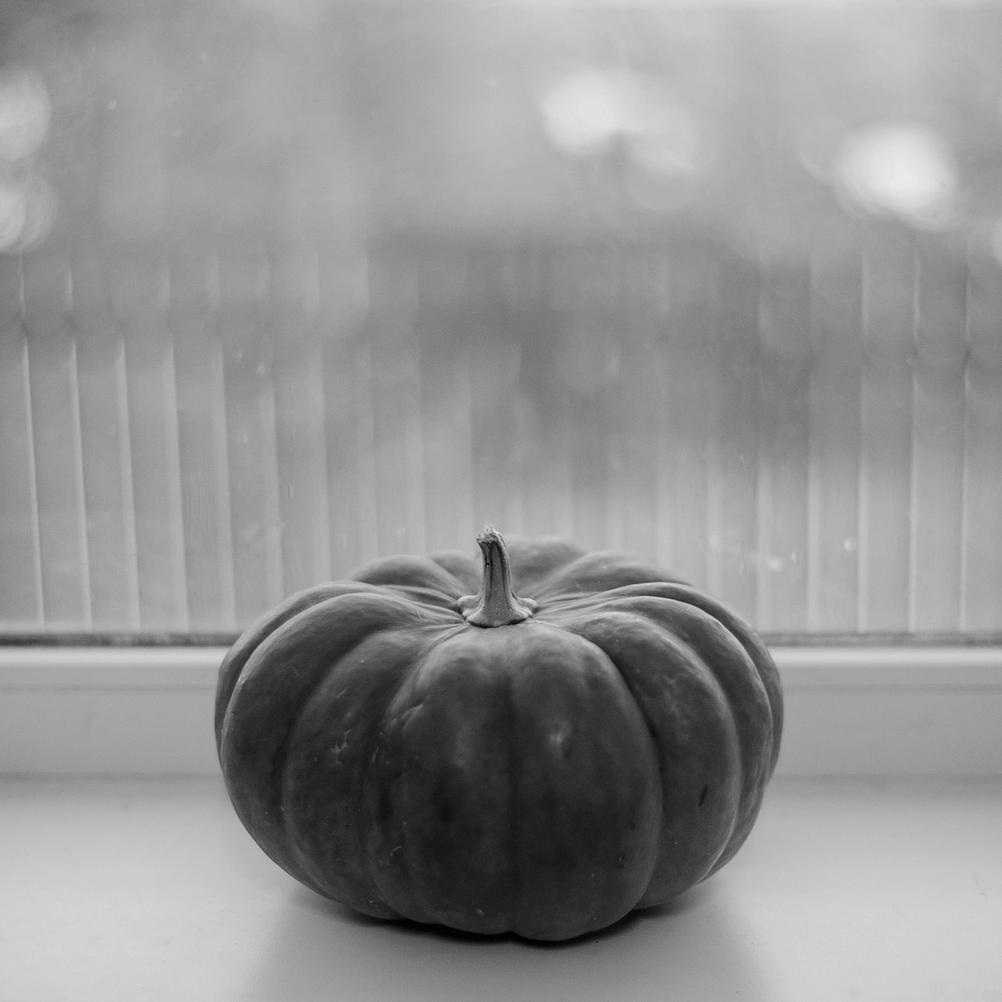
- Camera
- Leica M9
- Lens
- Canon LTM 50mm f1.2
Have I mentioned that I also like how pictures from M9 transform into black and white photos? I would like to try Leica M9M ( the monochrome version of M9 ).
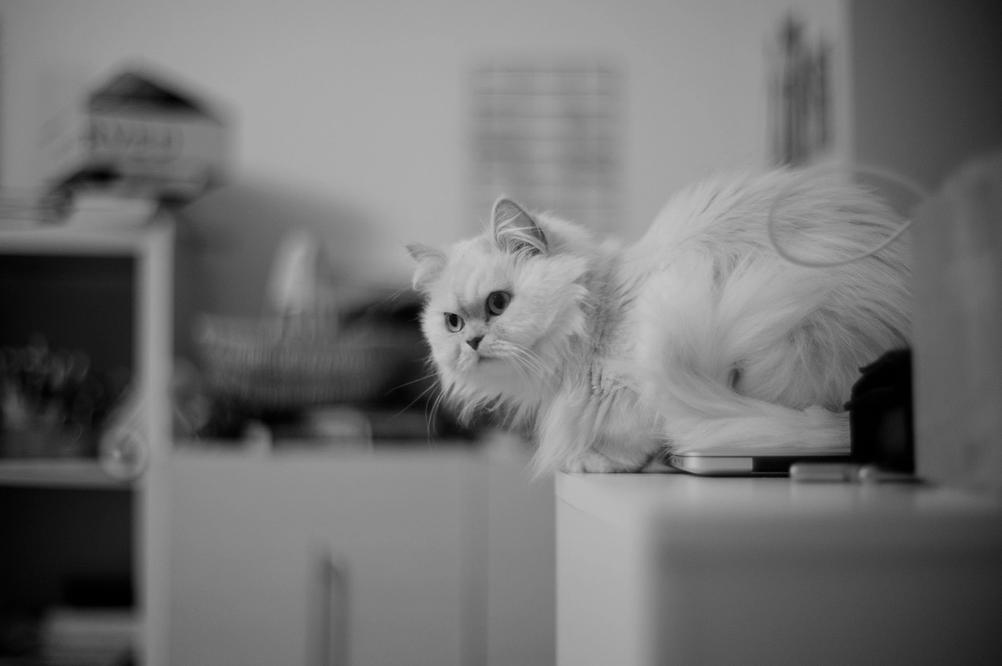
- Camera
- Leica M9
- Lens
- Canon LTM 50mm f1.2
Can a review even be a review without a cat?

- Camera
- Leica M9
- Lens
- Canon LTM 50mm f1.2
Ultimately the reason why I love M9 might be because it's the camera I find the easiest to document the life around me which typically is my family.
Rangefinder focussing seems easier to me when doing this than autofocus for some reason. And the output is weirdly intimate and familiar - something I haven't been able to capture with other cameras.
